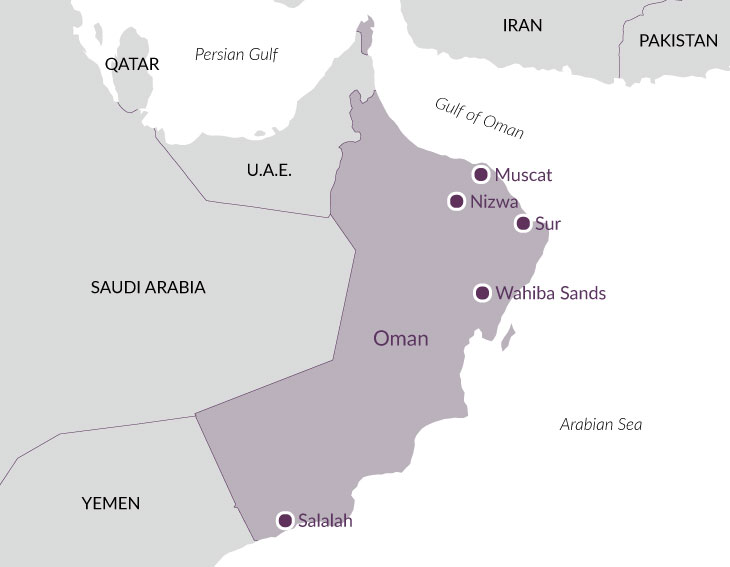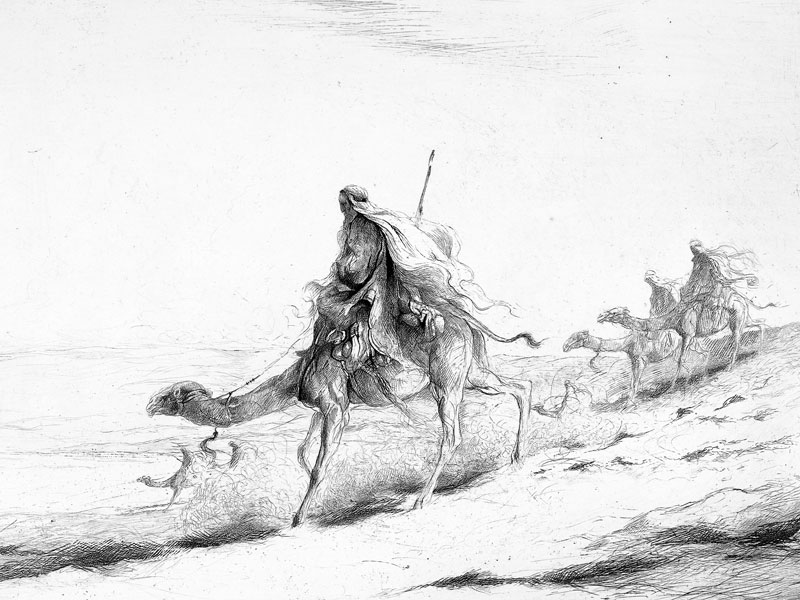Overview
Wilfred Thesiger was motivated to cross the Empty Quarter by the hope that he would find peace and solitude in the remote desert landscapes. He also yearned to gain the friendship of the Bedu who journeyed with him and whom he encountered during his traverse. The opportunities for travelling to little-visited locations, relaxing in inspiring surroundings and encountering new peoples is no less possible in Oman today than it was in 1946.
The country provides a diverse range of extraordinary natural beauty: deserts, mountains, wadis, beaches. Visitors also experience the kindness and friendliness of the Omanis. With relatively low – although gradually increasing – numbers of visitors, Oman is still not over-developed, unlike some of its neighbouring Gulf states.
Evidence of settlement dates back to the fourth millennium BC with early indications of dependence on trade. First copper and then ‘sacred frankincense’ (southern Oman is one of the few places in the world where it still grows) played a key role in the country’s history. Desire to control the supply of frankincense led to incorporation in the Achaemenid and Sassanian empires until the Persians were forced out in the seventh century.
Omanis readily embraced Islam and submitted to the Umayyad and the Abbasid Caliphate. Trade and naval power continued to expand. Occupied by the Portuguese from 1507 to 1650, Oman flourished again after their departure with an empire reaching into East Africa, particularly Zanzibar, and the Indian Ocean. Treaties agreed with the British to protect communications with India marked the beginning of a special relationship which continued beyond the formal termination of the protectorate in 1971.
Meanwhile, the division of the Omani empire between the sultan of Zanzibar and the sultan of Muscat in 1856 resulted in economic decline for both and internal conflicts in the latter. Successive sultans failed to tackle the problems and Oman stagnated.
The coming to power of Sultan Qaboos bin Said in 1970 heralded a new era. Though its oil revenues are relatively small, they have been used wisely to the benefit of the Omani people, for infrastructure, employment and education. Development has been rapid but controlled, guided by a determination to preserve Omani traditions.
Our comprehensive itinerary includes the highlights of this vast country: from the inland forts of Nizwa and Jabrin to the little-visited archaeological sites of Al-Balid and Khor Rori, from the mountain scenery in the Western Hajar to the remoteness of the Wahiba Sands, from the bustling capital Muscat to the contrasting landscapes of the southern region of Dhofar.
Other features of this tour are the opportunity to camp overnight in the Wahiba Sands, bathe in the Indian Ocean, stay high in the mountains of the Jabal Akhdar and shop in souqs suffused with the scent of frankincense.
Day 1
Fly at c. 8.00pm from London Heathrow (Oman Air) for the seven-hour overnight flight to Muscat.
Day 2
Muscat. Land at c. 7.15am. Hotel rooms are at your disposal for the morning. Greater Muscat is spread out along the coast with a dramatic mountain backdrop. Afternoon visit to the recently opened Omani National Museum, the Sultanate’s flagship cultural institution. First of two nights in Muscat.
Day 3
Barka, Rustaq. By 4-wheel-drive to the traditionally furnished 17th-century fortified house Bait Na’aman. Continue onto the impressive Rustaq Fort, an early 18th-century construction, built to defend the former Omani capital.
Day 4
Muscat, Jabrin. With seven minarets, the Sultan Qaboos Grand Mosque is impressively ornate. Leave Muscat by 4-wheel- drive. The most impressive fort in Oman is at Jabrin; sensitively restored, the plasterwork, wood carvings and painted ceilings are magnificent. Ascend the Al Hajar mountains for the first of three nights in the Jabal Akhdar.
Day 5
Nizwa area. Visit to the 17th-century Nizwa Fort, palace, seat of government and prison. Some time to explore the fascinating souqs and markets. Then see Al Hamra, a traditional Omani town at the foot of the Hajar mountain range; where the original irrigation system (falaj) remains in use. The rarely-visited archaeological site of Al Ayn is a collection of Bronze Age beehive tombs sitting atop a rugged ridge with the Jebel Misht as a backdrop.
Day 6
Nizwa area. A morning walk passing through three local villages. A free afternoon to enjoy the mountain scenery from the hotel.
Day 7
Nizwa, Wahiba. Set off early for Ibra, the once opulent market town that stood on the trade route linking the interior to the coast. Arrive at Wahiba Sands, a sea of high rolling dunes. Watch the sunset and camp overnight in the desert.
Day 8
Wahiba, Salalah. 4-wheel-drive to Muscat to catch an afternoon flight to Salalah, which despite its size is considered Oman’s second city and capital of the Dhofar region. First of three nights in Salalah.
Day 9
Al Balid. Ancient Zafar flourished in the 11th and 12th centuries and was visited by Marco Polo. The museum exhibits finds from the ruins of Al Balid and other artefacts from the area. Some free time before dinner to relax by the Indian Ocean.
Day 10
Khor Rori. Spend the morning at Mirbat, scene of the well-documented battle in 1972, which saw Pakistani and Omani British soldiers defend the town during the Dhofar Rebellion. The impressive archaeological site at Khor Rori, formerly known as Sumhuraman, preserves the remains of an important frankincense trading port from where, 2000 years ago, this precious commodity commenced its transportation to Damascus and Rome.
Day 11
A mid-morning flight to Muscat connects with the early afternoon flight to London, arriving Heathrow c. 6.30pm.
For those not taking the group flights, the tour ends in Salalah.

Dr Peter Webb
Lecturer in Arabic at Leiden University and a specialist in the cultural history of the Muslim world. Peter has travelled extensively across the Middle East and Central Asia and has studied at the Universities of Damascus and Isfahan. He held a fellowship at the Museum of Islamic Art, Berlin, where he researched Muslim architecture and Arabic calligraphy, studying monuments of medieval Egypt and Uzbekistan. In Oman, he studied pre-Islamic sites and local shrines dedicated to ancient Arabian prophets in as part of his current research focus on the legends and history of Arabia. His publications include Imagining the Arabs (Edinburgh University Press, 2016), a comprehensive exploration of the Arab people in early Islam, and The Arab Thieves (Brill, 2019), a critical study of Arabian outlaw tales.
Price, per person
In 2024: Two sharing: £6,810 or £6,060 without flights on days 1 and 11. Single occupancy: £8,040 or £7,290 without flights on days 1 and 11.
In 2025: Two sharing: £7,290 or £6,390 without flights on days 1 and 11. Single occupancy: £8,680 or £7,780 without flights on days 1 and 11.
Included
Included: flights (economy class) with Oman Air (aircraft: A330-300 or Boeing 787 & 737); travel by private air-conditioned coach and 4-wheel-drive vehicles; hotel accommodation; breakfasts, 8 lunches (3 picnics) and 8 dinners with a glass of wine or two, water and coffee (not all restaurants serve alcohol and none is served at picnics); all admissions; all tips; all taxes; the services of the lecturer, tour manager and local guides.
Internal flight
The flight from Muscat to Salalah on day 8 is included in the price if you take our ‘without flights’ option. However, please note that the tour ends in Salalah and therefore the internal flight from Salalah to Muscat on day 11 is not included.
Visas
For stays of up to (and including) 14 days, citizens of the UK, US, Canada and Australia can obtain a Tourist Visa on arrival in Oman.
Whilst it is possible to apply for a Visa online in advance, the Omani authority’s website is unreliable and difficult to navigate. We therefore recommend obtaining a Visa on arrival and will share further information on this simple process closer to departure.
You will need to provide proof of accommodation and return travel on arrival in Oman. We will provide these in your final documents.
Citizens of other countries should check their own requirements.
Passports must be valid for at least 6 months after your return from the tour.
Accommodation
InterContinental, Muscat: 5-star hotel within an exclusive resort. Anantara, Jabal Akhdar: located in the Al Hajar mountains with spectacular views. Desert Nights Camp, Wahiba Sands: luxury camp; individual tents with private facilities. Hotel Crowne Plaza, Salalah: 5-star hotel, high standards of comfort and service. Single rooms are doubles for sole occupancy throughout.
How strenuous?
This is a busy and active tour and participants need stamina and fitness. There are some long journeys by 4x4 vehicles or coach (average distance per day: 102 miles), at least one internal flight and 3 changes of accommodation. Walking is often on uneven terrain at archaeological sites, hill forts and in the desert.
Are you fit enough to join the tour?
Group size
Between 10 and 22 participants.
Travel advice
Before booking, please refer to the FCDO website to ensure you are happy with the travel advice for the destination(s) you are visiting.
Combine with
In January/ February 2025:
Caravaggio, 13–20 January

'I felt immersion as usual on one of your tours in the history and culture of Oman. Muscat was a glittering new city. The mountains were devouring, vast, lumbering, ragged, beautiful in the heart. Loved the deserted villages, the odd oasis in the midst of scrubby desert.'
'A range of fascinating and contrasting experiences. I really valued the academic input. We were able to visit places where very few tourists went. The highlight of the trip was the time spent in the desert camp.'
'The itinerary was well developed giving a good overview to the country, its background, history and people. I have learnt a lot about Oman on this trip, and feel that I will be much more informed in the future as the country continues to develop.'
'Peter's vast knowledge and infectious enthusiasm, coupled with an ability to communicate with lesser intellectual mortals, made this trip truly memorable. I have come back with a real desire to learn a little Arabic and to return to Oman to learn more.'
'Peter Webb made the history of this fascinating country come to life. I enjoyed and appreciated his lectures, which were well prepared and stimulating. Peter was good company, and it was wonderful that he was so available to take any number of questions throughout the tour.'
